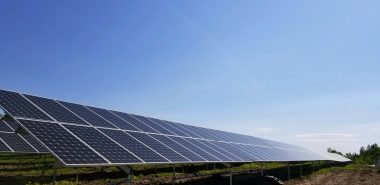Hudson River Historic Boat Community Solar Fundraiser Information Sheet
Eleanor has relied on renewable wind energy. Now households can access renewable energy too,
and support Eleanor’s restoration at the same time.

This information sheet is for Hudson River Historic Boat members and their friends and family who are interested in supporting the restoration of Eleanor by subscribing to clean, low-cost electricity from a solar farm.
I. About the Fundraiser
What is the general idea?
HRHB is using the NYSERDA community solar program to connect households to clean, low-cost electricity from solar farms. For each household that subscribes our partner, Common Energy, contributes $50 to HRHB.
 How much money can HRHB raise?
How much money can HRHB raise?
The amount HRHB can raise is determined by the capacity of the solar farms and number of subscribers that enroll using the HRHB community solar web page at commonenergy.us/hrhb. The solar farms we’re working with can accommodate about 1,000 average size homes, so HRHB could see 1,000 homes subscribe. For each household that subscribes, Common Energy contributes $50 to HRHB.
Who can participate?
New York State residents with a National Grid (NGRID) or New York State Electric and Gas (NYSEG) account for residential electricity can participate.
How to participate?
To participate visit commonenergy.us/hrhb. It should take less than 5 minutes to enroll. You will need your utility account number from your electric bill and your routing and account number from your bank account. There is no installation at your home and you pay no money until you receive credit from the solar farm on your electric bill.
When does HRHB receive the contribution for subscribers?
Common Energy will make contributions once participants have completed their registrations. For participants enrolled in a given month, Common Energy will make the contribution to HRHB by the end of the following month.
II. About Community Solar
 How does the NYSERDA community solar program work?
How does the NYSERDA community solar program work?
The NYSERDA community solar program allows households to subscribe to electricity produced by a solar farm. The electricity produced at the solar farm is allocated by the utility to households who have subscribed. The energy produced by the solar farm shows as a credit, like a gift card, on your utility electric bill. In the accompanying sample electric bill, the lines highlighted in yellow are credits resulting from production of electricity at the solar farm. These credits reduce the amount you pay to the utility.
Is there any installation on my property?
There is no installation on your property because the solar energy comes from solar panels already installed on the solar farm.
When I subscribe to community solar am I changing my utility or electricity supplier?
Your utility and electricity supplier will remain the same and will not change. NGRID or NYSEG will continue to be your utility and if you have chosen an alternative electricity supplier that will not change either. Since you will continue with your existing supplier, you will not be terminating your agreement with the supplier.
III. About the Solar Farms and the Community Solar Subscription
Where are the solar farms?
One of the solar farms we are working with is in Oppenheim NY and two are in Johnstown NY. The photo at the top of the page is of one of the Johnstown farms.
How much solar electricity will the solar farms produce and how much is allocated to me?
The solar farms produce more electricity on long days in the summer and less electricity on short days in the winter, but over the course of a year, these three solar farms will produce enough electricity to power about 1,000 average homes. When you enroll, a Common Energy representative will review your 12-month electricity consumption history which is on file with the utility and allocate a percentage of the solar farm’s production to your account to match your electricity usage. Then each month the electricity production allocated to your account will be automatically reflected as a credit on your electric bill.
How much money will I save on my electricity?
Electricity produced by these solar farms always costs 10% less than what you pay to NGRID. For example, if you received a $40 community solar credit on your electric bill, you’d pay only $36 for that credit, which means you save $4 or 10%. Think of the credit like purchasing a gift card and you pay only 90% of the value of the gift card. The credit applies to all the charges on your electric bill. You will always save 10% versus utility cost for as long as you participate. You will receive a savings statement via email each month from Common Energy. The savings statement will indicate how much electricity was produced at the solar farm and allocated to you, and how much money you saved.
What do I need to know about the subscription agreement?
The subscription agreement explains what you will receive from the community solar program, how much it costs, and other specifics of the program. Important things to know are: cost of electricity (always 10% less than you would have paid to the utility), is there a required deposit (no, you pay nothing until you receive credits on your electric bill); length of agreement (five years and automatically renews); ability to cancel (cancel with no penalty by notifying Common Energy 90 days in advance); how do I pay (automatic ACH from your checking account).
IV. Other
Has this ever been done before?
There is a lot of community solar in Colorado, Minnesota, and Massachusetts. NYSERDA’s community solar program in New York has been created more recently but there are already a lot of solar farms being built in the state. In New York State, Common Energy is already enrolling subscribers across utility load zones C, D, E, and F which reach from Allegany County in the west to Clinton County and the Canadian border in the north and Columbia County in the South.
What if the solar farms or Common Energy are destroyed by natural disaster or business failure?
In the unlikely event that the solar farms cease to operate you would receive no further credits on your electric bill. You would receive electricity from your utility and any other alternative supplier as you always have. In the unlikely event that Common Energy should cease to exist, you would not be billed for and would not pay for credits you receive on your electric bill for a period of time until the assets and responsibilities of Common Energy are acquired by another company. In that case the new company must abide by the subscriber agreement between you and Common Energy. In no event would any of these unlikely disruptions interfere with delivery of electricity to your home — you would continue to receive electricity as you did prior to subscribing to community solar.
Will carbon emissions be avoided by using community solar?
Yes. An average household will reduce carbon emissions by 90% by subscribing to community solar. That’s about 90,000 lbs of carbon dioxide over 20 years. You would need to plant about 2,000 trees to absorb that much carbon dioxide.
Who can I speak to if I have other questions?
For questions about enrolling please contact Common Energy customer service at 1-844-899-9763, Support @commonenergy.us. For questions about the fundraiser please contact Malcolm David Bliss at 518-620-1694, Malcolm@commonenergy.us or Louise Bliss at 518-828-7884, eleanorrestorationproject@gmail.com.
5/25/2018
